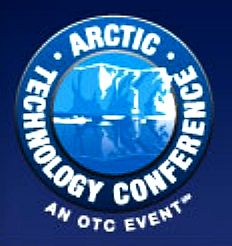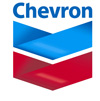|
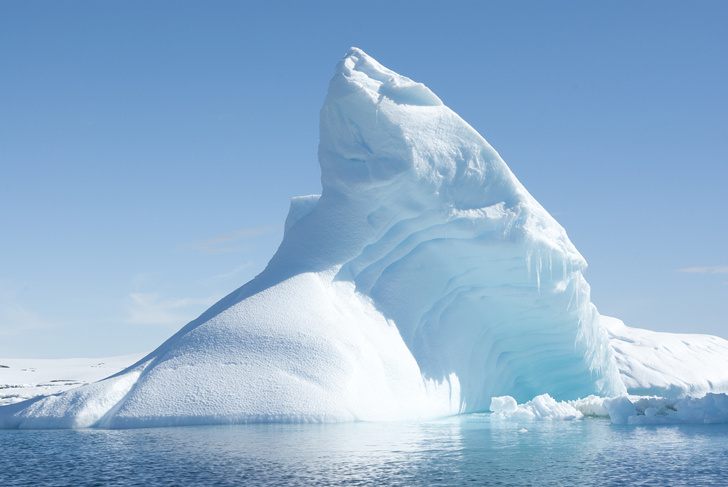
It
is ironic that global warming is making the arctic more accessible, so making it easier for us to find more fossil fuels to burn to
increase global warming and melt the ice caps. It's a sort of perpetual
nightmare for environmentalists, and talk about a catch 22
situation. But energy companies are [snow] blinded to that in the rush to keep energy fuels flowing
to keep our high carbon lifestyles afloat an their bank balances in the black
until the slime
until runs out.
THE
OTC
The
Offshore Technology Conference (OTC) was founded in 1969 to help companies
exploit fossil fuel reserves. It is one of the
world’s foremost events promoting offshore resources in the
fields of drilling, exploration, production and lastly environmental protection.
We say lastly, because the best way to protect the environment is to leave
it alone and develop other energy sources.
The
ATC is supported through OTC’s network of renowned scientific and professional
societies. ATC provides a worldwide platform for you to communicate and collaborate with industry colleagues, vendors and academia about challenges and solutions for the
arctic regions. The
conference boasts a technical program of over 150 presentations, high quality speakers, networking events and an Arctic-focused exhibition
area.
A
three day program includes Panel Sessions devoted to Arctic Core Capabilities, Arctic Past Projects, The Global Arctic Market Outlook and worthwhile experiences from Arctic Trailblazers. In addition, technical experts will present papers in their respective disciplines and topical luncheons will offer insights into Arctic themes, both from a technical as well as a socio-economic point of view.
The Arctic Technology Conference (ATC) is built upon OTC’s successful
multidisciplinary approach. 14 technical societies and organizations all
work together to deliver what is claimed to be the world’s most
comprehensive Arctic event:
* 150+ Presentations
*
4 Topical Luncheons
*
5 Panels and Special Sessions
*
Exhibition Luncheon
*
ATC on Ice Receptions
Conference
registration includes many thought-provoking panels:
*
Plenary Session
*
Arctic Core Capabilities
*
Arctic Trailblazers
*
Arctic Past Projects
*
Global Arctic Market Outlook — Pushing the Frontier
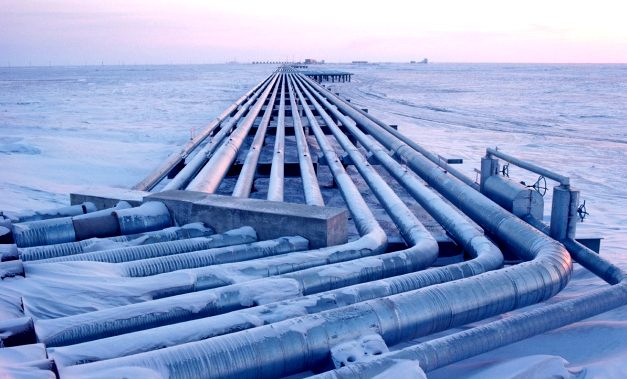
EXHIBITION
The exhibition is the ideal place to research suppliers or the latest technologies available for the Arctic. Don’t miss your chance to meet face-to-face with vendors, discuss products and services, and learn more about the latest offerings. While you’re on the exhibition hall floor you can research solutions, network with colleagues and enjoy refreshment breaks.
POLITICS
Climate change may be set to adversely affect hundreds of millions of people, but there are some who see a potential boom in the northernmost extremity of the planet. Commercial shipping sees the melting ice as a way to save travel time by up to 25% between Rotterdam and Korea, avoiding the lengthy route through the Suez Canal and passing instead above Russia - known as the Northeastern Passage.
It has only been in recent years that ships have been able to do this, given the receding of Arctic ice. It has also relied upon Russian bureaucracy’s willingness to facilitate transport, by allowing ships in its Arctic ports and by providing ice-breakers.
There is a treasure trove of untapped resources hidden beneath the Arctic Ocean waiting to be claimed. According to the United States Geological Survey, around a quarter of the world’s undiscovered oil and gas reserves lay
there.
Determining who actually owns the ground to be explored is a fastidious task. The
UN Commission on the Limits of the Continental Shelf (UNCLOS) allows a ten-year period for nations to stake territorial claims, based on the territorial limits of a continental shelf.
Russia is set to claim up to 380,000 square miles of the internationally owned Arctic in the next year. Whatever the Commission decides, and it is reasonable to assume that Russia has a legitimate claim to the lion’s share of territory from geographical dominance over smaller nations such as
Norway. The biggest problem is that Russia’s most powerful rival in the region, the US, hasn’t yet ratified
UNCLOS.
DIFFICULTIES & CHALLENGES
Drilling for oil and gas has always been a risky business. The world’s precious hydrocarbon resources are rarely found in convenient locations; overcoming technical, political and environmental challenges is part of the job.
In September 2012 Christophe de Margerie, chief executive of French oil giant Total, broke ranks. When it came to the Arctic Ocean, he declared, the risk of a spill was simply too high.
While many of his peers clearly disagree with his assessment that drilling for oil should not proceed, few would dispute the unique risks of the fragile region. For the environment and the companies involved, a spill in the Arctic could be catastrophic.
In the Alaskan Arctic, where Royal Dutch Shell began drilling offshore in October 2012, temperatures drop to minus 20 degrees celsius in summer. Gale force winds move giant ice floes forcing Shell’s drilling rig to get out of the way of one ice block bigger than Manhattan. In winter, when daylight lasts barely a few hours, sea ice forms, makes the region inaccessible.
“The drilling conditions facing oil companies operating in the Arctic are some of the most challenging on Earth,” Greenpeace argues. “The hostile weather, freezing conditions and remote location present unprecedented challenges for dealing with a spill.”
Vicky Wyatt, a campaigner with the group, says the lack of infrastructure and the winter advance of sea ice could make cleaning up almost impossible. “If you can’t cap a leak in time before the Arctic winter, the well will continue flowing until the ice melts again and you can get to it,” she is quoted as saying. The oil could become frozen underneath individual ice floes – floating hundreds of miles away over the course of the winter before being released into the ocean in the spring.
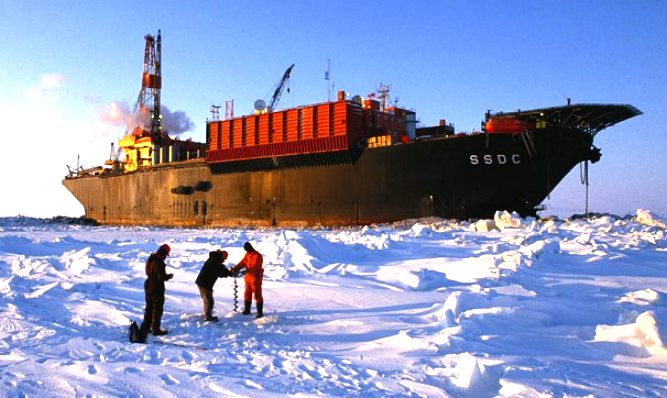
From a reputational point of view, there could be no worse place to spill the black stuff. “You have a very stark image there with the white of the Arctic ice,” says Dr Mark McClelland of risk consultants Maplecroft. “It would be devastating. It would be as bad, if not worse, as the reputational damage that BP experienced in the Gulf of Mexico.” Yet despite the risks, most of the world’s biggest oil companies are eyeing the Arctic. Shell has faced numerous setbacks and delays but is pressing ahead off Alaska; US giant ExxonMobil has signed an exploration deal for the Russian Arctic with Rosneft, as have Italy’s Eni and Norway’s Statoil. Statoil is also working in the Norwegian Arctic and is partnering Cairn Energy off Greenland. And future Arctic exploration is seen as the implicit long-term goal of BP’s declared interest in Russia. The reason: the sheer volumes of oil and gas that are thought to be there.
A US Geological Survey estimates that the Arctic may hold 90bn barrels of oil – almost three times annual global consumption and some 13pc of the world’s undiscovered oil reserves. There may also be 1,669 trillion cubic feet of
natural gas – 30pc of global undiscovered reserves. And the vast majority of it lies offshore.
As production in easier-to-access areas declines, oil companies are turning to new, more challenging frontiers. Meanwhile, melting sea ice is making the Arctic more accessible.
In the US, questions remain over political tolerance for drilling. “You have had some senior Democrat senators requesting that the Arctic is removed from the interior department’s leasing programme over the next five years,” McClelland says. But most of the governments in the Arctic region are eyeing the potential riches, with Canada, Greenland, Norway and Russia seen as key growth areas.
Meeting the high standards required to drill in the Arctic does not come cheaply. Shell has so far spent $4.5bn without even gaining permission to drill into oil-bearing rocks. “It needs very high oil price to make it sustainable – at least $90-$100 a barrel,” McClelland explained to a Telegraph journalist. With infrastructure almost non-existent, development costs are also huge.
The challenges of the Arctic mean the region is likely to remain the province of the supermajors, Stuart Joyner of Investec is quoted as saying. “You need a lot of capital, the balance sheet to withstand things going wrong and the expertise of running great big multi-billion barrel projects,” he says.
Meaningful production is unlikely to emerge until well into the next decade at the earliest. But, Joyner says, the challenges will eventually be overcome. “I think you will get commercial production from there in quite large volumes – in the US, potentially in Greenland, and certainly in Norway and Russia. Technology is moving on all the time and the industry is becoming more capable. It is within the competencies of the industry to get to a position where we can get commercial discoveries.”
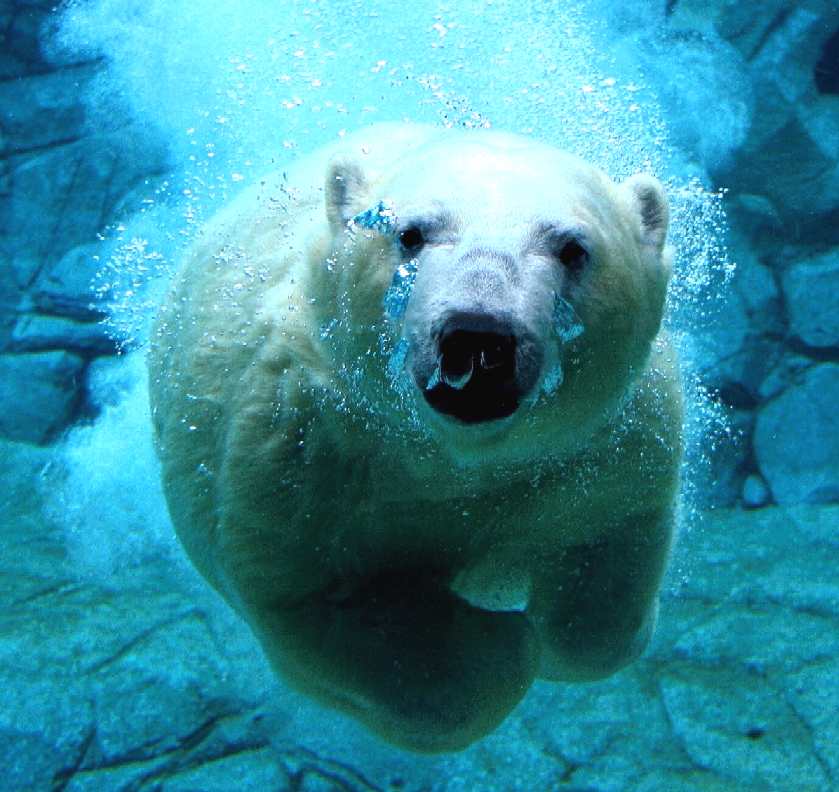
CONFERENCE
PROGRAM
|
The
Arctic Technology Conference is an international event focused on
continuing innovative technologies and solutions needed for
exploration and production of energy within the circum-Arctic. The
ATC 2014 technical program includes senior industry executives and
professionals who share knowledge and expertise on the challenges
and successes encountered in the harsh conditions of the Arctic,
bound to include emergency plans to deal with the inevitable oil
spills - and presumably financial reserves that should be set
aside to pay for clean ups.
Oil
executives will not won't want to miss the ideas and results shared in the
various panel
sessions, topical
luncheons and oral sessions listed below offered throughout
the conference. Click through the detailed technical program menu
and make the most of your time at ATC 2014. You may also download
a copy of the ATC
Preview.
Plenary
Session
09:00-12:10
/ Grand Ballroom B
Co-Chairs:
Han Tiebout and Brian Miller
Opening Remarks: Ed Stokes, OTC Board of Directors
|
09:15
|
Richard
Glenn, Executive Vice President of Lands and
Natural Resources, Arctic Slope Regional Corporation
|
|
09:30
|
Ray
Gosine, Associate Vice-President (Research) and a
Professor and J.I. Clark Chair in the Faculty of
Engineering and Applied Science at Memorial
|
|
09:45
|
Konstantinos
Makrygiannis, Senior Development and Operations
Engineer, KUFPEC
|
|
10:00
|
Jonathan
S. Spaner, Captain, US Coast Guard
|
|
10:15
|
Refreshment
Break
|
|
11:00
|
Jan
Vapaavuori, Minister of Economic Affairs, Finland
|
|
11:15
|
Kathy
Dunderdale, Premier of Newfoundland and Labrador
|
|
11:30
|
Mead
Treadwell, Lieutenant Governor of Alaska
|
|
11:45
|
Lisa
Murkowski, US Senator for Alaska
|
|
12:00
|
Question
and Answer
|
MONDAY
TOPICAL LUNCHEON
12:45-13:55
/ Room 320
Tickets
are US $55
The
Pursuit of Environmental Science in Support Arctic Offshore
Exploration
A. Michael Macrander, Chief Scientist, Shell Alaska
Exploration
for offshore oil and gas in the U.S. Outer Continental Shelf
presents a suite of physical, environmental, social, and
regulatory challenges that are unique in the industry. This
presentation will provide an overview of the Alaskan Arctic
environment and social setting. The regulatory requirements will
be explored, as well as the special challenges of active global
opposition to Arctic resource development.
The
presentation will provide an overview of the Shell Arctic Science
program and how it provides support to operations, regulatory
affairs, and long term planning. Case studies will present
specific examples of problem solving through application of an
active science program.
MONDAY
TOPICAL LUNCHEON
12:45-13:55
/ Room 332
Tickets
are US $55
Sirluaq
3-D— Beaufort Sea Marine Seismic
Kevin Williams, Manager of Exploration
Operations, Chevron Canada Resources
As
exploration pushes further into the Frontier areas, challenges
escalate dramatically. Remote locations, lack of infrastructure
and harsh weather are a few of the issues that must be recognized
and addressed before embarking on an exploration project.
In
the summer of 2012, Chevron Canada Resources acquired 3700 square
kilometers of exploration 3D on EL 460 in the Canadian Beaufort
Sea. Years of planning and preparation culminated in the most
successful offshore seismic exploration effort ever undertaken in
the Canadian arctic. A large, high resolution data set was
acquired in a remote location in a very constricted time window.
No safety incidents occurred and there was negligible impact on
the environment.
Monday
Afternoon
14:00-17:00
Technical Sessions
15:15-15:55
Refreshment Break
17:00-18:00
ATC on Ice Reception and Spotlight on Technology Awards
Presentation
Ice
Loads: Analytical and Model Testing I
Grand
Ballroom A
Chair:
George Li
|
14:00
|
An
Ice-Structure Interaction Model for Non-Simultaneous Ice
Failure: B. Yu, D. G. Karr*
(University of Michigan)
|
|
14:25
|
An
Implementation of ISO 19906 Formulae for Ice Loads on
Fixed Structures Within a Probabilistic Framework Using
the Sea Ice Loads Software: M. Fuglem, M.
Richard, A. King (C-CORE)
|
|
14:50
|
Numerical
Simulations of Ice Loads on an Arctic Floater in Managed
Ice: T. H. Amdahl, B. E. Bjørnsen, S. R. Søberg,
O. J. Hagen (Ship Modelling & Simulation Centre AS)
|
|
15:15
|
Refreshment
Break
|
|
15:55
|
The
Development of Ice Ridge Keel Strengths: E.
Bailey1, J. Bruce1, A. Derradji2,
M. Lau2 (1. C-CORE; 2. National Research
Council)
|
|
16:20
|
Quantile
Regression - A Statisticians Approach to the Local Ice
Pressure-Area Relationship: T. Morrison, P.
Spencer (Ausenco)
|
|
16:40
|
Quantile
Regression Applied to the Global and Local Pressure Trends
in ISO 19906: P. Spencer, T. Morrison (Ausenco)
|
Panel:
Arctic Core Capabilities
Grand
Ballroom B
Moderator:
Skip Ward
-
Mike
Paulin, Operations Director, INTECSEA, Global
Subsector Leader-Arctic Worley Parsons — Arctic Pipelines
-
Peter
Noble, Advisor, Noble Associates LLC — Arctic
Offshore Drilling
-
Don
Connelly, Marine Operations, Chevron Arctic Center
— Marine Operations in Arctic Waters
-
Graham
Thomas, Principal, AN Thomas Consulting Limited —
Fixed Structures in Ice Environments
ICE
Properties and Metocean I
Grand
Ballroom C
Co-Chairs:
Thomas Krzewinski and Arto Uuskallio
|
14:00
|
Sea
Ice Thickness Surveying with Airborne EM - Grounded Ridges
and Ice Shear Zones Near Barrow, Alaska: S.
Hendricks2, P. Hunkeler1, H. Eicken3,
A. Mahoney3, T. Krumpen2, L.
Rabenstein*2 (1. Alfred Wegener Institute; 2.
Drift & Noise GmbH i.G.; 3. University Alaska)
|
|
14:25
|
The
Role of RADARSAT-2 SAR Data for Ice Seismic Operations:
G. Staples1, R. Pierce2, B. Rabus1
(1. MDA; 2. Ion Geophysical)
|
|
14:50
|
Case
Study of the September 2012 Anchorage Windstorm:
A. J. Artzer, M. Barnett, J. Basciani (ImpactWeather,
Inc.)
|
|
15:15
|
Refreshment
Break
|
|
15:55
|
Autonomous
Surface Vehicles for Arctic Data Collection: B.
S. Anderson, A. Kleiner (C&C Technologies/ASV Services
Division)
|
|
16:20
|
Met-Ocean
Services by FMI for Ice Management and Shipping in Ice:
S. Majaniemi, P. Eriksson*, M. Lensu, J.
Karvonen (Finnish Meteorological Institute)
|
Production
Facilities and Structures I
Room
310
Co-Chairs:
Chris Knudsen and Medhi Kharrazi
|
14:00
|
A
Disconnectable Dry Tree Semisubmersible Design Exposed to
Iceberg and Harsh Environment: A. M. Mansour, M.
Dib, J. James, D. Kumar (INTECSEA, Worleyparsons Group)
|
|
14:25
|
Arctic
Offshore Islands - Lessons Learned: K. Hewitt
(Chevron Arctic Center)
|
|
14:50
|
GBS
LNG Solution for Shallow Arctic Regions: J. Raven1,
J. Maughan*1, E. Pinnerod2 M.
Egge2(1. KBR; 2. Kvaerner)
|
|
15:15
|
Refreshment
Break
|
|
15:55
|
Steel/Concrete
Composite Ice Walls for Arctic Offshore Structures:
M. Wernli, M. W. LaNier, K. Hjorteset (BergerABAM)
|
|
16:20
|
Dynamic
Response of Submerged Buoys Disconnected at Large Vessel
Offsets: V. Srivastava, J. Hallai, J. Huang, B.
Campbell, D. Fenz, T. Kokkinis (ExxonMobil Upstream
Research Company)
|
|
16:45
|
Deep
Floating Concrete Platform with Storage Facilities:
J-D Advocaat, J.M. Munkeby, J. Jørgensen, M. Rioda, H.B.
Østlund (Kvaerner)
|
Tuesday
Morning
09:00-12:10
Technical Sessions
10:15-10:55
Refreshment Break
Ice
Loads: Analytical and Model Testing II
Grand
Ballroom A
Co-Chairs:
Walt Spring and Walter Kuehnlein
|
09:00
|
Best
Practice in Ice Model Testing on Moored Floaters:
P. Jochmann, K. Evers, A. Haase (The Hamburg Ship Model
Basin, HSVA)Best Practice in Ice Model Testing on Moored
Floaters: P. Jochmann, K. Evers, A. Haase (The Hamburg
Ship Model Basin, HSVA)
|
|
09:25
|
Conical
Structures in Ice: The Roles Friction, Slope and Shape
Play: A. Barker, M. Sayed (National Research
Council)
|
|
09:50
|
Influence
of Wave-Induced Heave Motions of Icebergs on Risks to
Subsea Equipment: M. Fuglem, F. Ralph (C-CORE)
|
Health,
Safety, Environment (HSE)
Grand
Ballroom A
Co-Chairs:
Tom Gee and George Moridis
|
11:00
|
Impact
of Lubricating Materials on Arctic Subsea Production
Systems: A. Akulichev, B. Thorkildsen (FMC
Kongsberg)
|
|
11:25
|
Stations
and Terminals Modeling for Risk and Reliability Assessment:
J. L. Martinez Gonzalez1, I. Perez Taylor1,
L. Martinez Gomez2, A. Garcia Hernandez3,
E. M. Rodriguez Betancourt1 (1. Pemex; 2.
Corrosion & Protection; 3. Southwest Research
Institute)
|
Arctic
Trailblazers
Grand
Ballroom B
Moderator:
Gus Cammaert
-
Richard
Glenn, Executive Vice President of Lands and Natural
Resources, Arctic Slope Regional Corporation — Native
Traditional Arctic Experience for Future Arctic Developments
-
David
Dickins, Ice/Oil Spill Expert, Chevron Arctic Center
— Emergency, Escape and Rescue (EER) Systems Experience
in the Arctic
-
Brian
Wright, Senior Ice/Concepts Advisor, Chevron Arctic
Center — Floating Structures in Ice
-
Kevin
Hewitt, Geotechnical/Ice, Chevron Arctic Center —
Application of Technology for Artificial Islands
-
R.J.
Brown, Director, R.J. Brown Deepwater, a Technip
Company — Execution of an Arctic Pipeline Project
Pipelines
& Export (Pipeline Integrity Structure)
Grand
Ballroom C
Co-Chairs:
John Bomba and Chris Knudsen
|
09:00
|
Magnetic
Tomography Method (MTM) - A Remote Non-Destructive
Inspection Technology for Buried and Sub Sea Pipelines:
I. Kolesnikov (Transkor Group Inc)
|
|
09:25
|
Countermeasures
for Bending and Abrupt Uplift of a Full-scale Test Chilled
Gas Pipeline Observed at Boundary Between Frozen Ground
and Talik: S. Akagawa (Cryosphere Engineering
Laboratory)
|
Regional
and Social Development
Grand
Ballroom C
Co-Chairs:
Jennifer Young and Kerry Fellers
|
11:00
|
Aboriginal
Engagement and Development of Northern Projects:
A. L. Reich, G. Bosgoed*, D. Willier, B.
Collett (WorleyParsons)
|
|
11:25
|
Engaging
with an Indigenous Arctic Population: Listening and
Building Trust from the Ground Up: E. Ede (Statoil)
|
Production
Facilities and Structures II
Room
310
Co-Chairs:
Mehdi Kharrazi and Han Yu
|
09:00
|
Fixed
Platforms Development Challenges in Ice Infested Arctic:
R. Eie, G. Rognaas (Kvaerner)
|
|
09:25
|
Ice
Breaking and Accumulation Around a Moored Structure: Ice
Basin Tests and Numerical Simulations: B.
Bonnemaire1, T. Lundamo1, N. Serré1,
A. Fredriksen1, A. Jensen1, A.
Gürtner2 (1. Multiconsult; 2. Statoil)
|
|
09:50
|
Station-Keeping
in Ice – Normative Requirements and Informative
Solutions: P. Liferov (Statoil ASA)
|
|
10:15
|
Refreshment
Break
|
|
11:00
|
Arctic
Mooring Systems - The Past, Present, and Future:
C. T. Kwan1, J. Bond2, H. Yu2,
A. Morandi3 (1. Kwan Engineering Services; 2.
American Bureau of Shipping; 3. Global Maritime)
|
|
11:25
|
Feasibility
of a Conical Piled Monopod in Multiyear Ice Environment
Offshore Northern Alaska: R. Aurora (ConocoPhillips
Company)
|
|
11:50
|
Monotower
Steel GBS Concept and Design Considerations: C.
Wu, C. Ji* (Intecsea)
|
Drilling
I
Room
320
Co-Chairs:
Carlos Salamanca and Robert Ziegler
|
09:00
|
Effective
Monitoring of Auroral Electrojet Disturbances to Enable
Accurate Wellbore Placement in the Arctic: B.
Poedjono1, S. Maus2 (1. Schlumberger;
2. Magnetic Variations)
|
|
09:25
|
Temperature
Modeling Used to Change Freeze Protection Procedures in
North Slope Disposal Wells: L. Nofziger, A. Di
Lullo, K. Hester (Eni)
|
|
09:50
|
Opportunities
and Challenges for Arctic Oil and Gas Development:
E. Stromquist1, R. Johnston1, D.
Biette2 (1. The Eurasia Group; 2. The Wilson
Center)
|
|
10:15
|
Refreshment
Break
|
|
11:00
|
Experimental
Set-Up for Testing Cement Sheath Integrity in Arctic Wells:
A. Albawi2, M. Torsaeter*1, N.
Opedal1, A. Stroisz1, T. Vrålstad1
(1. SINTEF Petroleum Research; 2. Norwegian University of
Science and Technology (NTNU))
|
|
11:25
|
Exploration
Drilling with Riserless Dual Gradient Technology in Artic
Waters: S. Sverre, C. Endresen, R. Rezk, G.
Tingvoll, M. Thorkildsen (AGR)
|
|
11:50
|
New
Fluid and Solids Control Management Equipment Onboard
North Sea Rid Reduces Cuttings Waste Volume and Improves
Arctic Related Challenges: T. Grelland, J.
Vasshus (Cubility AS)
|
Oil
Spill Response
Room
332
Chair:
Victoria Borje
|
09:00
|
Arctic
Pipeline Leak Detection Using Fiber Optic Cable
Distributed Sensing Systems: P. Thodi (INTECSEA
Canada)
|
|
09:25
|
Spectral
Fluorescence/Reflectance Optical Sensor Systems for Arctic
Oil Spill Detection and Mapping: D. A. Richter1,
G. Mooradian1, E. Marttila1, M.
Solonenko1, E. Saade2 (1. QinetiQ
North America; 2. Fugro EarthData, Inc.)
|
|
09:50
|
Advancing
Oil Spill Response in the Arctic: J. V. Mullin (OGP)
|
|
10:15
|
Refreshment
Break
|
|
11:00
|
Technological
Development in Oil Recovery in Ice Conditions: G.
W. Wilkman, A. Uuskallio, E. Ritari*, M. K.
Niini (Aker Arctic Technology Inc.)
|
|
11:25
|
Innovative
Solutions for Arctic Oil Spill Management: M.
Kajosaari (Arctech Helsinki Shipyard)
|
Tuesday
Afternoon Technical Sessions
14:00-17:00
Technical Sessions
15:15-15:55
Refreshment Break
17:00-18:00
ATC on Ice Reception
ICE
Properties and Metocean II
Grand
Ballroom A
Co-Chairs:
Walt Spring and Walter Kuehnlein
|
14:00
|
NE
Greenland Ice Study Group and Recent Project Work:
B. Wright1, J. Hammeken-Holm2, S.
Robertson1, V. Renganathan1 (1.
Chevron Arctic Center; 2. Bureau of Minerals and
Petroleum)
|
|
14:25
|
The
Identification of Extreme Ice Features in Satellite
Imagery: D. Power, I. Zakharov, P. Bobby (C-CORE)
|
|
14:50
|
Characterization
of Hazardous Ice Using Spaceborne SAR and Ice Profiling
Sonar: Preliminary Results: K. Ersahin, E. Ross,
L. N. Brown, K. Borg, D. Fissel, G. Borstad, T. Mudge (ASL
Environmental Sciences Inc.)
|
|
15:15
|
Refreshment
Break
|
|
15:55
|
The
Sensitivity of Ice Keel Statistics to Upward Looking Sonar
Ice Draft Processing Methods: E. Ross1,
O. Ekeberg2, D. Fissel1, T. Mudge1,
A. Kanwar1, D. Sadowy1 (1. ASL
Environmental Sciences Inc.; 2. Norwegian University of
Science and Technology)
|
Arctic
Past Projects Panel
Grand
Ballroom B
Moderators:
John Bomba and Norm Carnahan
-
Alan
Duguid, Drilling and Completions Lead Amauligak
Project, ConocoPhillips — Panarctic Drilling in the Canadian
Arctic Islands
-
Bill
Scott, Manager, Arctic Center, Chevron Canada Limited
— Drilling in Offshore Canada
-
Jim
Hawkins, Arctic Operations Manager, Imperial Oil
—Drilling from Ice Islands
Pipelines
& Export (Ice Scour)
Grand
Ballroom C
Co-Chairs:
Anne Barker and Rocky Taylor
|
14:00
|
Highly
Effective Sub-Arctic Pipeline Routing Evaluations Enabled
by Spatial AHP: C. N. White1, M. Paulin*1,
A. Palejwala1, K. Mower2 (1.
INTECSEA 2. WorleyParsons.)
|
|
14:25
|
Ice
Scour Simulation Database: Review and Knowledge Gap
Analysis of Available Numerical Models: M. H.
Babaei, D. Sudom (National Research Council Canada)
|
|
14:50
|
A
Database on Physical Simulations of Seabed Gouging by Ice
Keels: Analysis and Critical Knowledge Gaps: P.
D. Barrette1, D. Sudom2 (1.
Consultant; 2. National Research Council Canada (NRC))
|
|
15:15
|
Refreshment
Break
|
|
15:55
|
Ice
Gouging Effect on Pipelines: P. Liferov1,
H. Nes1, J. Asklund2, K. Shkhinek3
(1. Statoil ASA; 2. Simulia Scandinavia; 3. St. Petersburg
State Polytechnical University)
|
|
16:20
|
Trenching
of Pipelines for Protection in Ice Environments:
M. Paulin, J. Cocker, D. DeGeer (INTECSEA)
|
|
16:45
|
Arctic
Offshore Pipeline Design and Installation Challenges:
M. Paulin, D. DeGeer, G. Lanan (INTECSEA)
|
Emergency,
Escape and Rescue (EER)
Room
310
Co-Chairs:
Wayne Hamilton and Claude Brancart
|
14:00
|
Peak
Ice Loads on a Lifeboat in Pack Ice Conditions:
A. Kennedy1, A. J. Simoes Re*1, B.
Veitch2 (1. National Research Council; 2.
Memorial University of Newfoundland)
|
|
14:25
|
Accidents
and Emergency Response in the Arctic Sea: S.
Basharat1, K. Øien2 (1. Aker
Solutions MMO AS; 2. SINTEF)
|
|
14:50
|
Operability
of Lifeboats in Pack Ice: Coxswains' Skill and Design
Factors: R. Billard1, B. Veitch2,
S. MacKinnon2, A. J. Simoes Re3 (1.
Virtual Marine Technology Inc; 2. Memorial University; 3.
National Research Council)
|
|
15:15
|
Refreshment
Break
|
|
15:55
|
Arctic
Resources Preparation and Planning: P. Benedict
(BT Holdings)
|
|
16:20
|
ARKTOS
Shear Zone Evacuation Craft Self-Righting Model Tests:
T. A. Hall1, M. Kharrazi2, B.
Seligman3 (1. Hall Marine Design Ltd.; 2. Shell
International Exploration and Production Inc.; 3. ARKTOS
Developments Ltd.)
|
Drilling
II
Room
320
Co-Chairs:
Chengwu Yuan and Robert Ziegler
|
14:00
|
A
New Jack-up Unit Concept to Extend the Arctic Drilling
Season: A. Nandan, S. Imtiaz, S. Butt (Memorial
University of Newfoundland)
|
|
14:25
|
Control
of Bottom Hole in Managed Pressure Drilling Using IMC
Controller: M. Urycheva, O. Gudmestad*
(University of Stavanger)
|
|
14:50
|
Drilling-with-Casing
System Continues Successful Drilling of Permafrost
Sections in Arctic Circle of Western Siberia (Russian
Federation): G. Valiyev, D. Priymachenko, S.
Beattie, S. Kulikov (Weatherford)
|
Codes
and Standards
Room
320
Co-Chairs:
James Bond and Abdel Ghoneim
|
15:55
|
Arctic
Operations Handbook JIP: E. Wiersema1, F. Lange2,
G. Cammaert4, F. Sliggers4, W. Jolles5, C. van der Nat3
(1. Heerema Marine Contractors; 2. Shell; 3. Bluewater
Energy Services BV; 4. TU Delft; 5. Canatec Associates
International Ltd.)
|
|
16:20
|
Design
Method for ISO 19906 Arctic Offshore Structures:
G. A. Thomas (Graham A N Thomas Consulting Limited)
|
G
eology
and Geophysics
Room
332
Co-Chairs:
Michael Enachescu and Bill Goodway
|
14:00
|
Innovative
Seismic Acquisition Techniques Improve Data Quality on
Alaska's North Slope: O. Winter, P. Maxwell, R.
Schmid, H. Watt, E. Bathellier*(CGG)
|
|
14:25
|
Application
of Ground Penetrating RADAR for Profiling and Bathymetric
Survey of Shallow Frozen Lakes: W. J. Lee, R.
Poeckert (TerraSond Limited)
|
|
14:50
|
Simultaneous
Dual Vessel Marine 3-D Seismic Acquisition in Baffin Bay,
Greenland: M. Makhorin1, F. Smit2,
D. St. Peter1, T. Williams3, P.
Fontana1 (1. Polarcus; 2. Shell Global
Solutions International; 3. ION GX Technologies)
|
|
15:15
|
Refreshment
Break
|
|
15:55
|
Broad-Band
Source Signature Modelling to Assess the Environmental
Impact of Seismic Exploration in Vulnerable Regions:
J. F. Wisløff, A. V. Goertz*, J. Ali (PGS
Geophysical AS)
|
Wednesday
Morning Technical Sessions
09:00-12:15
Technical Sessions
10:15-10:55
Refreshment Break
Ice
Loads: Analytical and Model Testing III
Grand
Ballroom A
Co-Chairs:
Roger Cordes and Michael Coyne
|
09:00
|
Ice
Load Estimation Methods for LNG Jetty Design in Various
Ice-Structure Interactive Conditions: N. Nakazawa1,
T. Terashima2 (1. Systems Engineering
Associates, Inc.; 2. Kumashiro System Frontier Co., Ltd.)
|
|
09:25
|
Ice
Load Calculation for Arctic Structures and Pipelines Using
3-D Dynamic Non-Linear Finite Element Analysis:
N. O. Akinci1, Q. Lu1, A. Sari1,
S. Wang2 (1. Atkins; 2. Bechtel)
|
|
09:50
|
Global
and Local Iceberg Loads for an Arctic Floater: I.
Jordaan1, P. Stuckey2, P. Liferov3,
F. Ralph2 (1. CroasdaleJordaan Research Inc.;
2. C-CORE; 3. Statoil ASA)
|
|
10:15
|
Refreshment
Break
|
|
11:00
|
First
Year Ice Rubble: Shear Resistance and Rock Berm
Interaction: R. Phillips, R. McAffee, J. Barrett
(C-CORE)
|
|
11:25
|
Gaps
in Knowledge and Analysis Technology of Ice-Gouge-Pipeline
Interaction: A. Eltaher (MCS Kenny)
|
|
11:50
|
Methodology
for Combined Local and Global Ice Pressure Estimation
Based on a Probabilistic Model of High Pressure Zone
Behaviour Derived from Field Data: R. S. Taylor,
M. Richard (C-CORE)
|
Panel:
Global Energy Outlook—Shaping the Future!
Grand
Ballroom B
Moderators:
Kerry Fellers and Jim Malachowski
-
Edward
Richardson, Analyst, Infield
-
Thomas
Brown, Professor Emeritus, Department of Engineering,
University of Calgary (invited)
-
Konstantinos
Makrygiannis, Senior Development and Operations
Engineer, KUFPEC
-
Catherine Jahre-Nilsen,
Arctic Portfolio and Technology Manager, Statoil Arctic Unit,
Statoil
-
Darrin
Willhauer, Global Product Line Director, Baker Hughes
-
Tim
Crome, Director Sales & Business Development,
Technip
Ice
Breakers
Grand
Ballroom C
Co-Chairs:
Rod Allan
|
09:00
|
Results
Using Azipod Propulsion in Ice Management Operation:
S. Hanninen, T. Heideman, O. Toivanen (ABB Marine)
|
|
09:25
|
Increasing
Role of Marine Support in the Arctic Offshore Exploration
Drilling: A. Brovkin, D. Connelly, W. Scott
(Chevron Arctic Center)
|
|
09:50
|
Next
Generation to Break the Ice -The Oblique Icebreaker:
A. Uuskallio, M. Hovilainen*, T. Romu (Aker
Arctic Technology Inc.)
|
|
10:15
|
Refreshment
Break
|
|
11:00
|
On
Full-scale Ship Performance Measurements: G. W.
Wilkman, T. Heinonen, T. Leiviskä (Aker Arctic Technology
Inc.)
|
|
11:25
|
Development
of Icebreaking Ships: G. W. Wilkman, T. Mattsson
(Aker Arctic Technology Inc.)
|
Autonomous
Vehicles (Air, Land and Subsea)
Room
310
Co-Chairs:
Tom Gee and Claude Brancart
|
09:00
|
Sabertooth
a Seafloor Resident Hybrid AUV / ROV System for Long Term
Deployment: J. Siesjo (Saab North America, Inc.)
|
|
09:25
|
Sea
Ice Thickness Observed in Fram Strait: 1990-2011:
E. Hansen (Multiconsult)
|
|
09:50
|
Arctic
Relay Communications, Data Exchange and Enhancement
Protocol (ARCDEEP) Through-Ice High Data Rate Optical
Communication System: D. A. Richter1,
G. Mooradian1, E. Marttila1, M.
Solonenko1, E. Saade2 (1. QinetiQ
North America; 2. Fugro EarthData, Inc.)
|
|
10:15
|
Refreshment
Break
|
|
11:00
|
Small
Unmanned Aircraft Systems (SUAS) Supporting Safe, Cost
Effective, Environmentally Friendly Alternatives to
Surveillance and Science Gathering Requirements in
Hazardous Environments: M. Ziska (AeroVironment)
|
|
11:25
|
Use
of Unmanned Aerial Vehicles in the Oil and Gas Sector:
W. Pearce (Ingrobotic Aviation)
|
|
11:50
|
Unmanned
Aircraft Systems in Alaska Civil Reseach: K.
Cunningham1, M. Hatfield1, R.
Philemonoff2 (1. University of Alaska
Fairbanks, 2. Tanadgsix Corp)
|
Wednesday
Topical Luncheon
12:30-13:45
/ Room 320
Tickets
are US $55
The
Need for Relief Well Equivalency – An Industry and Stakeholder
Perspective
Bill Scott General Manager, Chevron Arctic
Center, Frank Pokiak, Chair, Inuvialuit Game
Council, Tuktoyaktuk, NWT, Canada
With
the post Macondo move towards shorter duration well secure
techniques, it is an appropriate time to get an industry and local
stakeholder view of these developments from an Arctic perspective.
Frank
Pokiak, Chair of the Inuvialuit Game Council (IGC), a key
stakeholder in the Canadian Beaufort Sea and Bill Scott, General
Manager of the Chevron Arctic Center, will outline their thoughts
on this key issue in a frank and open forum that will provide
attendees with a unique insight into both sides of this important
discussion.
Wednesday
Topical Luncheon
12:30-13:45
/ Room 320
Tickets
are US $55
The
Arctic: Opening of a New Ocean – Implications for the Energy and
Shipping and Offshore Sectors
Jostein Mykletun, Royal Norwegian Consulate
General
The
backdrop for the presentation is the dramatic changes taking place
in the Arctic Region, most importantly the fast melting of the
Arctic Ice Sheet, opening a new ocean.
Dr.
Mykletun will address the implications for maritime transport, the
exploration of offshore oil and gas, minerals, and the fishing
industry. Coupled to these factors and processes, the presentation
will include some wider geopolitical considerations pertaining to
the global energy mix, climate outlook, and international trade.
Wednesday
Afternoon
14:00-16:40
Technical Sessions
15:15-15:25
Break
Ice
Loads & Numerical Simulation
Grand
Ballroom A
Co-Chairs:
Roger Cordes and Abdel Ghoneim
|
14:00
|
Discrete
Element Method Helps Determine Load Levels for Ice-Capable
Jackups: S. Ji2, J. Liu*1,
H. Yu1 (1. ABS; 2. Dalian University of
Technology)
|
|
14:25
|
Implementation
of a Numerical Ice Tank Using a Physics Engine:
I. Metrikin, A. Gürtner (Statoil ASA)
|
|
14:50
|
A
New Ice Simulation Tool Using a Multi- Model Program:
B. Roberts1, C. Septseault2, P.
Béal*2, S. Le Yaouanq2, A. Dudal3
(1. Technip; 2. Cervval; 3. Bureau Veritas)
|
|
15:15
|
Break
|
|
15:25
|
Event
Mechanics Simulations for Ice Engineering Applications:
C. Daley (Memorial Univ.)
|
|
15:50
|
Numerical
Simulations of Ice Forces on Moored and Dynamic-Positioned
Drillships: M. Sayed1, I. Kubat1,
B. Wright2, J. Millan3 (1. National
Research Council; 2. B. Wright and Associates; 3. National
Research Council)
|
Operations
Grand
Ballroom B
Co-Chairs:
Albert Aalbers and Ed Wiersema
|
14:00
|
Aerial
Reconnaissance in Support of Arctic Drilling Operations:
Requirements, Potential Solutions and Challenges:
V. Y. Garas Yanni1, A. Simms2, T.
Lennox2, J. Hamilton1, J. Blunt1,
T. Kokkinis1 (1. ExxonMobil URC; 2. LPS AVIA
Consulting)
|
|
14:25
|
Cluster
Development of the Barents and Kara Seas HC Mega Basins
from the Novaya Zemlya Archipelago: Y. Efimov1,
A. Zolotukhin1, O.T. Gudmestan2, K.
Kornishin1 (1. Gubkin Russian State University
of Oil and Gas; 2. University of Stavanger)
|
|
14:50
|
Precise
GNSS Positioning in Arctic Regions: K. de Jong,
X. Liu, M. Goode, M. Stone (Fugro Intersite B.V.)
|
|
15:15
|
Break
|
|
15:25
|
DYPIC
Project: Technological and Scientific Progress Opening New
Perspectives: S. Kerkeni1, X. Dal
Santo1, O. Doucy1, P. Jochmann2,
A. Haase2, I. Metrikin3, S. Løset3,
N. Jenssen4, T. Hals4, A. Gürtner5,
P. Moslet6, S. Støle-Hentschel6 (1.
DCNS-Research/Sirehna; 2. HSVA; 3. NTNU; 4. Kongsberg
Maritime; 5. Statoil; 6. DNV)
|
|
15:50
|
Application
of a Novel Cable and Pipeline Detection Method for the
Arctic Environment: J. Nash (TerraSond Limited)
|
Ice
Management and Navigation
Grand
Ballroom C
Co-Chairs:
David Molyneux and Alain Wassink
|
14:00
|
A
Tactical Ice Management Simulation Methodology and
Approach: B. Wright1, R. McKenna2,
R. P. Browne1 (1. Chevron Arctic Center; 2. R.F.
McKenna Associates)
|
|
14:25
|
The
Question of Pack Ice Management and Some Associated
Realities: R. P. Browne, B. Wright, D. Connelly
(Chevron Arctic Center)
|
|
14:50
|
Design
of a Toolkit to Support Ice/Iceberg Surveillance and
Advisory Work for Offshore Petroleum Operations:
S. Tiffin (Canatec)
|
|
15:15
|
Break
|
|
15:25
|
Dynamic
Routing through Waters Partially Covered with Sea Ice:
P. Schütz (DNV Research & Innovation)
|
|
15:50
|
A
NRT Approach to Accurate Ice Edge Information: A.
Debien, P. Whitaker (Kongsberg Satellite Services)
|
Logistics
and Terminals
Room
310
Co-Chairs:
Rod Allan and Han Tiebout
|
14:00
|
The
MARENOR Project - Maritime Radio System Performances in
the High North: B. Kvamstad (MARINTEK)
|
|
14:25
|
Requirements
on Logistics to Tow Large Gravity Based Structures to the
Chukchi and Beaufort Sea: M. Wernli1,
K. L. FitzGerald2, K. Hjorteset1, M.
W. LaNier1 (1. BergerABAM; 2. The Glosten
Associates)
|
|
14:50
|
Managing
Offshore Superstructure Icing: C. Ryerson (Cold
Regions Research & Engineering Lab)
|
|
15:25
|
Arctic
Port - Relocatable: J. C. Lewis (JCLA Consulting
Ltd.)
|
|
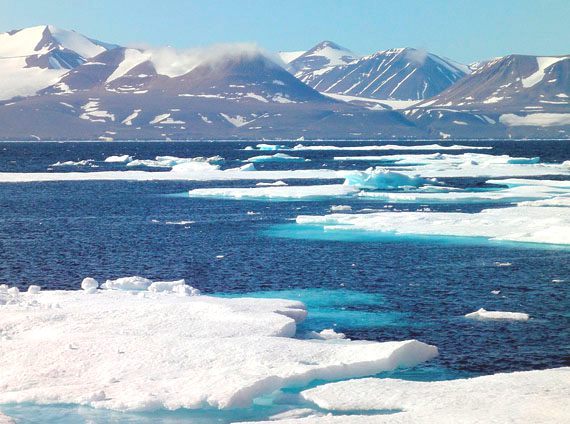
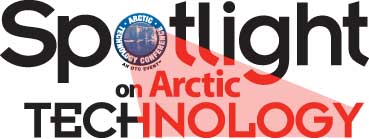
SPONSORS
Regional
Sponsoring Organization
Endorsing
Organizations
SPONSOR
COMPANIES
CONTACTS
Technical
Program
|
Terri
Duncan
Technical
Programs Coordinator
Direct: +1 918 560 2641
|
Exhibition
Sales and Sponsorship
|
Mike
Taylor
Exhibition
Sales Manager
Mobile: +1 281 773 8836
Pam
Murphy
Exhibition
Sales Representative
Mobile: +1 713 305 1039
Teresa
K. Dallis, CEM
Sales
Coordinator
Direct: +1 918 560 2696
|
Marketing
|
Samantha
Knowlton
Event
Marketing Manager
Direct: +1 918 560 2618
|
Operations
|
Theresa
Curry
Operations
Coordinator
Direct: +1 918 560 2683
|
Media
Inquiries
|
Vern
Stefanic
Communications
Manager
Direct: +1 918 560 2657
|
General Conference
Information
|
Telephone:
+1 888 945 2274
(Toll-free US and Canada)
Outside US and Canada: +1 918 560 2617
|




TOPICS
OF INTEREST
Product
Category
Acoustics
Batteries
Beacons & Buoys
Benthic Sampling Equipment
Buoys & Buoyancy Materials
Cables & Cable Systems
CADCAM
Cameras
Cathodic Protection
Compasses
Composite
Materials
Computer Equipment
Control
Systems
Deck Machinery
Displays/Mapping/Graphics
Diving Equipment, Contractors & Vessels
Echo Sounders
Electric
Motors
Global Information Systems
Gyrocompasses
Hydraulic Systems
Hydrological Instruments
Instruments/Instrumentation Systems
Lasers
Launch & Recovery Systems
Leak Detection & Sealing
Life Rafts
& Rescue Boats
Life Support Systems
Lighting
Magnets & Magnetometers
Manipulators
Mapping Systems
Marine Engineering
Marine Equipment - General
Marine Geotechnical Investigations
Marine Site Investigations
Marine Systems
Meters & Metering Systems
Naval Architecture
Offshore
Support & Accommodation Vessels
Oilfield,
Drilling & Fishing
Oil Spill Response
Patrol Craft
Position Fixing Systems
Power Supplies
Pressure & Temperature Control Measurement Equipment
Propulsion Systems
Pumps
Remote Sensing
Rescue & Survival Equipment
Robotics
Ropes - Woven, Wire & Mooring
ROVs
Safety, Survival & Security Equipment
Satellite Navigation Equipment
Seismic Equipment
Sensors
Shipbuilding, Repair & Conversion
Software & System Engineering
Sonar & Systems
Sonobuoys
Space Technology
Submarines
& Submersibles
Submersible Equipment
Subsea Production Systems
Surveillance Systems & Equipment
Survey Equipment
Towed Arrays & Bodies
Umbilicals
Underwater Communications
Underwater Vehicles
Winches & Accessories
Workboats
Service Category
Bathymetric
Survey
Charts & Charting
Coastal Protection
Communications
Consultancy Services
Current Measurement
Data Interpretation, Management & Processing
Diving
Dynamic Positioning
Earth Sciences
Ecological Health & Pollution
Ecology
Environmental Management
Equipment Hire
Geophysics
Geotechnical Engineering
Hydrographic
Services
Inspection, Repair & Maintenance
Laboratory testing services
Maritime Surveillance
Navigation & Position Fixing
Ocean Currents
Ocean Modeling
Ocean Observation
Oceanographic Survey
Oceanology
Optics
Optronics
Overhaul & Repair
Port Security
R&D Organisations
Safety & Survival Systems & Analysis
Seabed Sampling
Seismic Survey & Acquisition
Simulation & Training
System Modeling
Systems Integration
Target Acquisition & Recognition
Temperature Measurement
Test & Evaluation
Trials & Trials Facilities
Water Measurement, Sampling
End User Sector
Oil & Gas
Coastal Engineering
Aquaculture
Renewables
Ocean Science
Defense / Security
Desalination
Government
Telecommunications
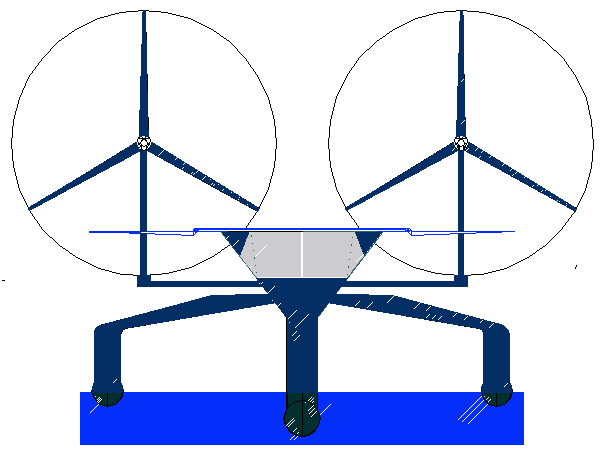
The
Combat ZCC is a 50 ton vessel that is
elongated, but retains the same low frontal area as with the merchant
Bluefish ZZC
platforms. The warship
variant can be armed with a potent mix of torpedoes,
SAM
and Cruise
missiles. The total energy harvesting capacity is around 176kW (235hp),
giving an Energy Harvested to Displacement ratio (EH/D) of 3.52kW/ton
(4.72hp/ton). Larger versions of this format could be the emission
free cargo ships of the future. The average cruising speed of this vessel
will be higher that the standard hull 50m (163ft) hull on the waterline,
giving a better speed/length ratio [nominal]. The OAL is 56M (183ft). The sprint
speed of this craft will be in the 20+ knot region using renewable energy
and 35 knot region during auxiliary combat mode. The cost of diesel fuel to
cruise this ship continuously for a year would be approximately: .29gals/hp x
117 x 24 x 365 = $297,226.80 (£183,393.99) In ten years that would be
$2.97M (£1.83M). There is though no fuel cost
during normal operations. Fuel for thought! Another vessel based on the
ZCC concept could clean our oceans of plastic waste, by operating as a drone
fleet.
MEDIA
LINKS http://www.economist.com/events-conferences/americas/world-ocean-summit-2014 http://inhabitat.com/shells-arctic-oil-drilling-efforts-halted-by-a-massive-rogue-iceberg/ http://www.oceanologyinternational.com http://www.telegraph.co.uk/Overcoming-challenges-of-Arctic-oil-drilling http://subseaworldnews.com/2013/05/02/sonardyne-names-new-non-executive-chairman-uk/ http://www.arabianoilandgas.com/article-4852-carbonate_evolution/#.UhCYTNKsg6Y http://www.maritimeindustries.org/Events/Oceanology-International-China-2013/9255
ARCTIC
- ATLANTIC - BALTIC
- BERING - CARIBBEAN
- CORAL - EAST
CHINA - ENGLISH CH - GULF
MEXICO
INDIAN
- MEDITERRANEAN - NORTH
SEA - PACIFIC - PERSIAN
GULF - SEA JAPAN - STH
CHINA
PLASTIC
OCEANS
|
